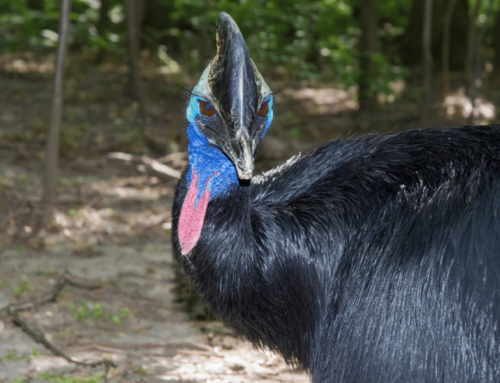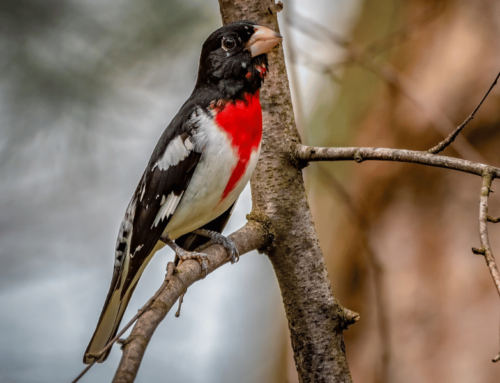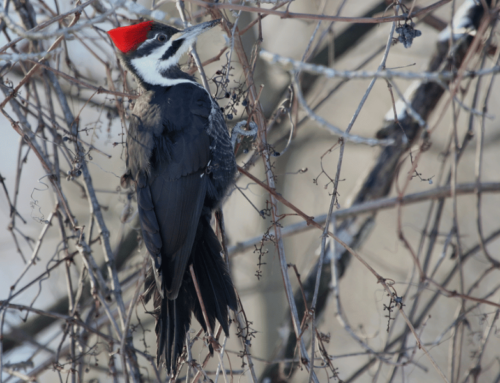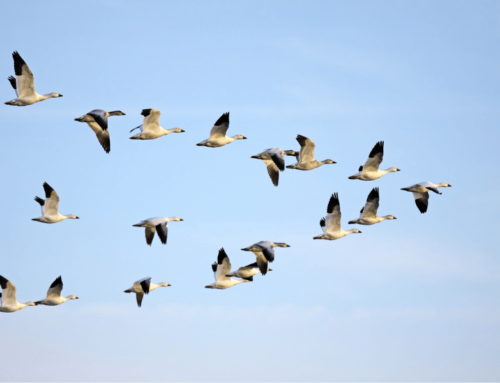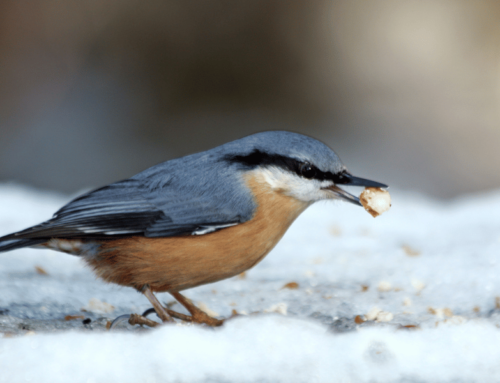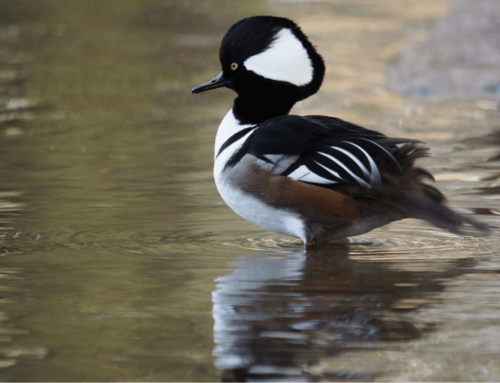The American Robin is a bird belonging to the thrush family. This birdwatching guide will go over their description, calls, range and behavior of the American Robin to give you an easier time finding and watching them in the wild. The American Robin is among the most common birds in North America and their arrival is associated with the start of spring. It’s likely that you already get a decent amount of exposure to them without any actual effort. This article is designed to help people who don’t normally get to see American Robins as frequently as others.
This article is a birdwatching guide for seeing the American Robin.
Birdwatching Guide for the American Robin
Description:
The American Robin was named because of its superficial resemblance to the European Robin. However, the two only have similar colors incidentally, not because they are closely related. The easiest way to recognize the American Robin is by its orange breast-area, a black-and-white head and grey-brown wings. Their bills are yellow. They remain small in size, with adults usually reaching the size of 10 inches. Their body shape is that of a typical perching bird.
The American Robin has little sexual dimorphism. On average the males will have more vibrant colors, but sexing Robins this way is not easy. Juvenile American Robins have paler coloration, and their orange breasts are broken up by dark spots.

Singing:
The American Robin’s song can sound almost continuous at times. Robins like to perch high in trees when they sing and they like singing in the early morning, including before dawn. When you pay attention to the robin’s singing, you’ll notice that it can change depending on the time of day. Like many species of songbird, the song can vary from region to region. Interestingly, Robins sing as a storm approaches and again after it has left.
The following contains an example of an American Robin singing.
Subspecies:
There are seven subspecies of American Robin. These include the Eastern Robin, the Southern Robin, the Western Robin, the Northwestern Robin, the San Lucas Robin, the Mexican Robin and the Newfoundland Robin. These subspecies are not distinct enough that you wouldn’t be able to recognize them as American Robins. Learning the differences between them isn’t necessary. There’s also a good amount of mixture between the subspecies, making their definitions a bit vague.
The only exception to this is the San Lucas Robin, which has a much browner and greyer appearance. They can be found on the southern areas of Baja California in Mexico. Although it’s smaller on average than other American Robins, the form of the San Lucas Robin is basically the same.
Range:
The American Robin has a large range throughout North America. Their year-round range covers the overwhelming majority of the United States along with smaller parts of Canada and Mexico. Their breeding range extends into almost all of Canada. Their range is cut off in the Caribbean and Central America. It is among the most abundant birds in North America, with its numbers edging out other ubiquitous species like house finches.
It can be a vagrant species in Western Europe and the Caribbean. In Europe, the majority of them that show up, can be found in the British Isles.
American Robins will migrate North into Canada in the summer. During the winter, they will migrate into the southern part of the United States and into central America. Their migration is food-based. The best time of year to see them in your area will depend on where you live. The summer is better for the Northern half of North America and the southern half is better in the winter. However, the majority of the United States can see Robins year-round.

Behavior:
The American Robin is active during the day. They are a year-round resident in much of North America. American Robins like to feed on worms and you can often find them hopping through grassy areas looking for them. Naturally, any area with lots of grassy area will make a good destination for finding American Robins.
A good time to see Robins eating is after it rains. Rain will bring worms and other insects out of the soil and out onto the ground. Robins will come out during this time to eat.
Although worms make up a big part of their diet, Robins eat a lot of berries and other fruits. Areas with lots of berries to eat will attract robins for you to watch.
The American Robin is one of the first birds to lay eggs in North America. A typical breeding season will have multiple broods from the same bird.
Nesting:
American Robins will usually nest in the lower parts of a tree, so look at the lower half of the tree to find their nests. However, robins won’t build nests that are too close to the ground. The nests are built by the female robin and will be completed in under a week. They can nest in the higher parts of a tree but it’s rarer. When looking for a robin’s nest, look at the lower parts of a tree that are at least a few feet above the ground.
The size of the next is usually around 6 inches in diameter. Nests are held together using mud.
You can recognize a robin’s nest by their eggs. Robins lay solid blue eggs without any spots. The eggs are small (around the size of a quarter). Female robins often make a new nest for each brood. This is true even if the next brood occurs in the same year.

Getting Robins to your Backyard:
As time has passed, the American Robin has gotten increasingly comfortable living in urbanized metropolitan areas. American and Canadian suburbs are very hospitable for them. You can increase the number of robins in your backyard by making it more attractive to them.
One way to see robins more frequently is to plant the right types of plants. A good choice includes junipers that produce berries.
American Robins don’t care for seeds. This is why robins aren’t seen at feeders much despite being a common sight elsewhere. If you do want to use a feeder to attract robins, you’re better off using raisins, dried meal worms or berries. An option for attracting robins is to use bird berry jelly, which is specifically designed for birds. Don’t use regular store-bought jelly, as it’s not clear if the preservatives or artificial sweeteners are good for them.
If you use a sprinkler system to water your lawn, check for robins after the watering is done. As mentioned before, this brings worms and other invertebrates to the surface. To keep their natural food sources present on your property, avoid using pesticide if you can. If there’s less invertebrates and insects in your yard, robins will find their food somewhere else.
With American Robins being more comfortable with being around people, they can and will nest in your backyard if you give them good nesting prospects. Putting up nesting boxes for them is one option for them. They’ll need a nesting box or bird house that around 8” by 8.” Make sure it’s at least five feet above the ground. It can be placed on the side of a building, where there is a clear flight path for the birds. A high-quality nest box can be purchased for only $40. Robins are less likely to use a house that is enclosed. Instead, try for a nest box that is more open.
If you are planning on planting trees and also want robins to nest on your property, get a tree that has lots of branches that extend horizontally. Robins like building their nests where a branch forks into two. If your house has lots of ledges, such as a windowsill, this will also attract robins for nesting.
Like most birds, American Robins need water. Providing a water source for them is a great way to see more of them. A bird bath is the easiest way to do this. A shallow amount of water is all that’s necessary.
One of the main predators of the American Robin is the domestic cat. This isn’t surprising as cats are among the most popular pets in North America and robins have increasingly become comfortable around human development.
An important way to keep robins showing up in your backyard is to keep cats out. If there are holes in your backyard’s fence, get them blocked or filled in. Installing a motion-activated sprinkler is a great-way to keep cats out. House cats don’t like getting wet and if you put a motion activated sprinkler in your backyard, this can scare cats away. If you’re in the process of putting up new fencing, the taller it is, the better. There are also ultrasonic devices that are designed to deter cats. These sounds can’t be heard by people but cats will be able to hear them.
If you have a cat, you should keep it indoors.
Conclusion:
The American Robin is one of the most common and recognizable migratory birds in North America. Their bright colors and singing make them a popular bird among birdwatchers. If you follow this birdwatching guide, you can increase your time watching and encountering them.
